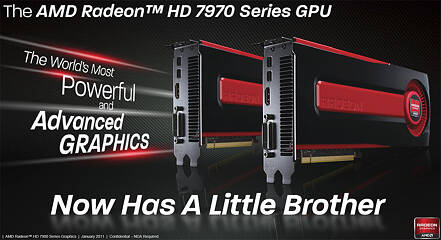 50
50
AMD Radeon HD 7950 3 GB Review
Packaging & Contents »Introduction

The cash-cow of AMD's 28 nanometer "Tahiti" silicon is finally here, as the company launched its new Radeon HD 7950 graphics card. The HD 7950 is an important model for AMD, as it allows more people access to the new Graphics CoreNext architecture as a result of its lower price. The new SKU was originally slated for a January 09, 2012 launch, but was faced with unforeseen delays. Regardless, today is its hard-launch date, meaning you should be able to find a Radeon HD 7950 at a store.
The Radeon HD 7950 qualifies as being a high-end graphics card due to its pricing, which is comparative to NVIDIA's GeForce GTX 580 with its current market pricing. AMD is aiming at higher energy efficiency compared to its market rival product, and a scope for aggressive cost-cutting, if competition from future NVIDIA product so dictate. In essence, AMD Radeon HD 7950 will serve as a fulcrum for both today's high-end price-point, and tomorrow's gamer sweet-spot, again, depending on its competitive environment. This is what makes it an important model for AMD.
The Radeon HD 7950 is carved out of the 28 nm "Tahiti" silicon, on which the HD 7970 is based. This is done so by lowering the number of Graphics CoreNext Compute Units (CUs) from 32 on the HD 7970 to 28, resulting in a stream processor count of 1,792 compared to 2,048 on the Radeon HD 7970, and a TMU count lowered from 128 to 112. Every other component is left unchanged, including the memory interface and memory amount. Historically, with NVIDIA GPUs that have 384-bit wide memory interfaces, we have seen the second-best SKU having a narrower memory bus (such as 320-bit wide, for example). This is not the case with HD 7950, which has the full 384-bit wide memory interface with 3 GB of GDDR5 memory.
We also have the following reviews for you today:
- PowerColor Radeon HD 7950 PCS+ Review (custom cooler & overclocked)
- AMD Radeon HD 7950 CrossFire Review (two cards in CrossFire)

The HD 7950, hence, features 1,792 GCN stream processors, 112 TMUs, 32 ROPs, and a 384-bit wide GDDR5 memory interface, holding 3 GB of memory. The clock speeds are slightly lowered compared to the HD 7970, the core is clocked at 800 MHz, and memory at 1,250 MHz (5.00 GHz GDDR5 effective), churning out 240 GB/s of memory bandwidth. In this review, we're testing AMD's reference design HD 7950 graphics card, which is similar in design to the HD 7970, except it has a lighter VRM, and draws power from two 6-pin PCIe power connectors instead of the 6+8 pin layout on the HD 7970.
| GeForce GTX 570 | Radeon HD 6970 | GeForce GTX 580 | Radeon HD 7950 | Radeon HD 7970 | Radeon HD 6990 | GeForce GTX 590 | |
|---|---|---|---|---|---|---|---|
| Shader Units | 480 | 1536 | 512 | 1792 | 2048 | 2x 1536 | 2x 512 |
| ROPs | 40 | 32 | 48 | 32 | 32 | 2x 32 | 2x 48 |
| Graphics Processor | GF110 | Cayman | GF110 | Tahiti | Tahiti | 2x Cayman | 2x GF110 |
| Transistors | 3000M | 2640M | 3000M | 4310M | 4310M | 2x 2640M | 2x 3000M |
| Memory Size | 1280 MB | 2048 MB | 1536 MB | 3072 MB | 3072 MB | 2x 2048 MB | 2x 1536 MB |
| Memory Bus Width | 320 bit | 256 bit | 384 bit | 384 bit | 384 bit | 2x 256 bit | 2x 384 bit |
| Core Clock | 732 MHz | 880 MHz | 772 MHz | 800 MHz | 925 MHz | 830 MHz | 607 MHz |
| Memory Clock | 950 MHz | 1375 MHz | 1002 MHz | 1250 MHz | 1375 MHz | 1250 MHz | 855 MHz |
| Price | $330 | $340 | $500 | $449 | $549 | $700 | $750 |
Apr 3rd, 2025 03:07 EDT
change timezone
Latest GPU Drivers
New Forum Posts
- RX 9000 series GPU Owners Club (116)
- Mllse 6600s that are locked at 500 mhz. (1)
- Since all gpu's models perform the same, why review dozen of different models? (4)
- Is RX 9070 VRAM temperature regular value or hotspot? (298)
- TechPowerUp Screenshot Thread (MASSIVE 56K WARNING) (4266)
- Windows 11 General Discussion (5917)
- Montech KING 95 - your opinions? (14)
- New AM5 build [help] (14)
- Looking for Palit 5090 Gamerock OC BIOS (21)
- The TPU UK Clubhouse (26037)
Popular Reviews
- DDR5 CUDIMM Explained & Benched - The New Memory Standard
- Sapphire Radeon RX 9070 XT Pulse Review
- SilverStone Lucid 04 Review
- PowerColor Radeon RX 9070 Hellhound Review
- Sapphire Radeon RX 9070 XT Nitro+ Review - Beating NVIDIA
- ASRock Phantom Gaming B850 Riptide Wi-Fi Review - Amazing Price/Performance
- Palit GeForce RTX 5070 GamingPro OC Review
- Pwnage Trinity CF Review
- AMD Ryzen 7 9800X3D Review - The Best Gaming Processor
- Samsung 9100 Pro 2 TB Review - The Best Gen 5 SSD
Controversial News Posts
- MSI Doesn't Plan Radeon RX 9000 Series GPUs, Skips AMD RDNA 4 Generation Entirely (146)
- Microsoft Introduces Copilot for Gaming (124)
- AMD Radeon RX 9070 XT Reportedly Outperforms RTX 5080 Through Undervolting (119)
- NVIDIA Reportedly Prepares GeForce RTX 5060 and RTX 5060 Ti Unveil Tomorrow (115)
- Over 200,000 Sold Radeon RX 9070 and RX 9070 XT GPUs? AMD Says No Number was Given (100)
- NVIDIA GeForce RTX 5050, RTX 5060, and RTX 5060 Ti Specifications Leak (96)
- Retailers Anticipate Increased Radeon RX 9070 Series Prices, After Initial Shipments of "MSRP" Models (90)
- China Develops Domestic EUV Tool, ASML Monopoly in Trouble (88)
